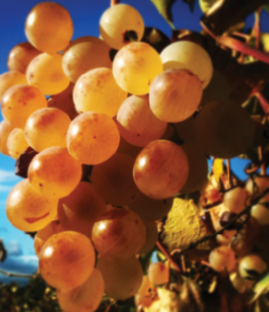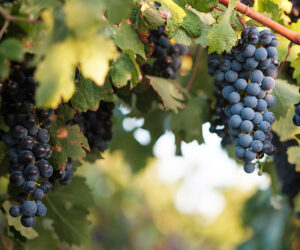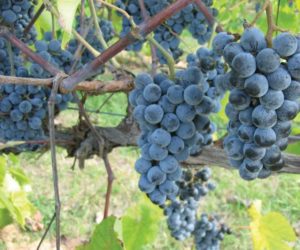 The Muscat grape family is one of the largest, and presumably oldest, grape families known. Jancis Robinson writes, “Muscat grapes are also distinguished by, uniquely, producing wines that actually taste and smell of grapes.” A bold statement. The Muscat grape is unique. Over the last several thousand years, the Muscat varieties have contributed to many wine styles, and have also been subject to the focus of numerous grape breeding programs. The Muscat grape family is hard to pin down with respect to identity; its members are white, golden, and red, and used in dry, sweet, and sparkling wines, as well as raisin production. Its wines are often lower in alcohol. One common thread through the members of the Muscat family is a distinctive aroma that is in the grapes and transferred to the products made from it. The level of that aroma’s expression varies depending on the specific Muscat grape type. In winemaking, these aromatics may translate passively, or rather naturally into the resultant wine, or can be enhanced with specific winemaking techniques. Muscat is one of the most aromatic grapes, which offers a perspective as to why it is so specialized in the wine types and other grape products it is used for.
The Muscat grape family is one of the largest, and presumably oldest, grape families known. Jancis Robinson writes, “Muscat grapes are also distinguished by, uniquely, producing wines that actually taste and smell of grapes.” A bold statement. The Muscat grape is unique. Over the last several thousand years, the Muscat varieties have contributed to many wine styles, and have also been subject to the focus of numerous grape breeding programs. The Muscat grape family is hard to pin down with respect to identity; its members are white, golden, and red, and used in dry, sweet, and sparkling wines, as well as raisin production. Its wines are often lower in alcohol. One common thread through the members of the Muscat family is a distinctive aroma that is in the grapes and transferred to the products made from it. The level of that aroma’s expression varies depending on the specific Muscat grape type. In winemaking, these aromatics may translate passively, or rather naturally into the resultant wine, or can be enhanced with specific winemaking techniques. Muscat is one of the most aromatic grapes, which offers a perspective as to why it is so specialized in the wine types and other grape products it is used for.
To understand this diversity of Muscat we have to visit the “Old World” of winemaking, where at least in this specific reference, all of these wine grapes are likely the same, given their geographical proximity to the Mediterranean Sea. In France, it is known as Muscat Blanc à Petit Grains, referring to the small, tight clusters populated with small berries grown in the south. Primarily a blending grape with Grenache Blanc, it does comprise the primary grape in wines produced in the Hérault, a region centrally located along the French Riviera. In the Alsace region, the Muscat of Alsace is synonymous with Petit Grains and another Muscat, Muscat Ottonel, to typically make dry wines in the region. In the Piedmont region of Italy, it is known as Moscato Bianco, and is the primary component of the Moscato d’Asti, and the well-known Asti Spumante, a sweet sparkling white wine.
The most diversity within a single region with the use of the Muscat grape that I have seen is in Greece. The small Greek island of Samos in the eastern Aegean Sea produces a bevy of Muscat wines from the Muscat Blanc. The vineyards of Samos produce wines that are a guaranteed appellation of origin. The grape comprises 97% percent of the island’s viniculture. The vineyards rise above the ocean on terraced hillsides to an elevation of about 3,000 feet (900 m). Both sweet and dry wine styles are produced. A notable example is the wine produced under the name Anthemis, which is a sweet version of Muscat that has been aged for five years in wood casks.
Vin Doux is called the island’s most popular with accolades that it is so good you have to “enjoy it in long relishing gulps!” The island’s two wineries produce five examples of dry wines. Given Samos’ close proximity to Turkey, an indigenous Muscat grape, Bornova Misketi, accounts for about 900 tons of local production on the nearby mainland.
An Old World grape with New World connections, Australia has produced Muscat-based wines for about a hundred years. The Rutherglen Muscats are classified into four wine styles, a base Muscat style, aging 2–5 years, the “Classic,” aging 5–10 years, the “Grand,” aging anywhere from 1–15 years, and the “Rare,” aging a minimum of 20 years. Each of these styles builds on the other for wines that are rich in complexity and flavor. The Rutherglen region also produces many fortified Muscat wines.
The distinctive aroma is due to the chemical class called terpenes. Terpenes in nature, are ubiquitous in many plant species. A quick search of the Internet using the keyword “terpene” results in a slew of pages that also contain the word “cannabis.” Now there’s an aroma I wouldn’t associate with grapes! I refined my search to “terpenes in wine,” which narrowed the field considerably. Terpene concentration in grapes and wine depend on various factors such as cultivar, region, and winemaking techniques. The most prominent terpene compounds occurring in Muscat and in generally high concentrations are linalool, geraniol, and nerol. These aroma compounds are generally bound to sugar moieties in the juice and wine. These are referred to as glycosides. The glycosides are not odiferous, but rather it is the liberation of the terpene molecule from the sugar that causes the compound to be aromatic. This “liberation” can be the result of a slower acid hydrolysis as the wine ages, or can be brought about with the use of enzymes.
Many companies exist that manufacture enzymes for use in winemaking; Scott Labs is one of the largest. Scottzyme BG and Lallzyme Beta are two products specific to releasing aroma compounds. What is important to note in use of enzymes is as follows and probably in order of importance. The first question to ask is whether the wine needs to be treated? If the wine needs to be treated, what is the best choice of enzymes? In making a decision to use enzymes, as a winemaker you have to consider how much aroma is present currently and how long will the wine be around before consuming. Unless the wine really lacks in aroma qualities, then the use of enzymes would not be warranted. The winemaker must also consider that the release of the aroma compounds can lead to premature degradation as the wines age. Another aspect in enzyme use to consider is over-expression of the aromatics, although most manufacturers quickly caution that this is not possible. When using enzymes, be cautious and follow the directions implicitly (and do not use enzymes with red varieties as the enzymes can potentially break down those stable glycosidic anthocyanins and destabilize color). Most enzymes used to release aromatics are added at the wine stage, as the presence of sugar is inhibitory to enzyme activity. Residual sugar concentrations of less than 0.5% are required and bench trials are highly recommended. Thus their uses in sweet styles of Muscat are useless.
Making Muscat-based wines has its challenges and if juice were available, then I would prefer that to the challenges of working with the fruit. My personal experience with Muscat of Alexandria in recent years was a grape that had a very gelatinous pulp, which can make maximizing juice yields during pressing challenging. As a home winemaker your choices are limited, but using rice hulls in your press cycle will help improve yields. I have tried this with other Muscat-based grapes with success. Many years ago I tried using enzymes to improve yields but the results were not so great. They wound up making a big mess and plugged the press repeatedly. Perhaps the use of enzymes and rice hulls together would work better.
What are the grapes that comprise the Muscats? The Vitis International Variety Catalogue (VIVC) lists almost 700 Muscat varieties in its database! Some of these varieties are duplicates as they are listed by their local synonyms, but as one of the oldest varieties known, it is no doubt that this has to be the largest grape family. Its members consist of both white and red berries, and can be used for wine, raisins, or table grapes. The aromatic qualities of Muscat make it a popular tool for the grape breeders. In the same database, almost 900 listings show Muscat being used as a parent. One of my favorite wines is Torrontes, which lists Muscat of Alexandria in
its parentage.
To best enjoy Muscat, my advice is to embrace the local cultivar and customs. Wherever Muscat is produced, there is a local story that defines the wine style and the foods that go along with it. In Alsace, a dry style we tasted paired very well with the local flatbread pizza topped with melon and jambon. Perhaps to the south, prosciutto would be the local tradition.
There are other aromatic varieties, like Riesling and Gewürztraminer (which share many of the same monoterpenols as Muscat varities), but their families are not as diverse as the Muscat. Those grapes have their specific place in the world, but it seems Muscat grapes are grown in all regions, either with a small part to play or a grandiose role celebrated by local custom. Embrace them for what they are. The real oenophiles do just that.
Muscat Wine Recipe (5 gallons/19 L)
Ingredients
100 lbs. (45 kg) Muscat fruit (or 6 gallons/23 L commercially available cold-settled clarified juice)
Distilled water
10% potassium metabisulfite (KMBS) solution. Weigh 10 grams of KMBS, dissolve into about 75 milliliters (mL) of distilled water. When completely dissolved, make up to 100 mL total with distilled water.
5 grams Lallemand QA23 yeast (Red Star Premier Cuvée can be used as a substitute)
5 grams Fermaid K (or equivalent yeast nutrient)
5 grams Di-ammonium Phosphate (DAP)
Other equipment or needs
5-gallon (19-L) carboy
6-gallon (23-L) carboy
6-gallon (23-L) plastic bucket
Airlock/stopper
Racking hoses
Equipment cleaning and sanitizing agents (Bio-Clean, Bio-San)
Inert gas (nitrogen, argon, or carbon dioxide)
Refrigerator (~45 °F/7 °C) to cold settle the juice (if using grapes)
Ability to maintain a fermentation temperature of 55 °F (13 °C)
Thermometer capable of measuring between 40–110 °F (4–43 °C) in one degree increments
Pipettes with the ability to add in increments of 1 mL
Ability to test or have testing performed for sulfur dioxide
Step by Step
1. Crush and press the grapes. Do not delay between crushing and pressing. Press lightly to avoid extended contact with the skins and seeds.
2. Transfer the juice to a 6-gallon (23-L) bucket. During the transfer, add 16 mL of 10% KMBS solution (This addition is the equivalent of 40 mg/L (ppm) SO2). Layer the headspace with inert gas and keep covered. Move the juice to the refrigerator.
3. Let the juice settle at least overnight.
4. When sufficiently settled, rack the juice off of the solids into the 6-gallon (23-L) carboy.
5. Measure the Brix and acidity, and adjust the acidity to 6.0-7.0 g/L.
6. Prepare yeast. Heat about 50 mL distilled water to 108 °F (42 °C). Measure the temperature. Pitch the yeast when the suspension is 104 °F (40 °C). Sprinkle the yeast on the surface and gently mix so that no clumps exist. Let sit for 15 minutes undisturbed. Measure the temperature of the yeast suspension and of the juice. You do not want to add the yeast to your cool juice if the temperature of the yeast and the must temperature difference exceeds 15 °F (8 °C). To avoid temperature shock, acclimate your yeast by taking about 10 mL of the juice and adding it to the yeast suspension. Wait 15 minutes and measure the temperature again. Do this until you are within the specified temperature range. Do not let the yeast sit in the original water suspension for longer than 20 minutes. When the yeast is ready, add it to the fermenter.
7. Add Fermaid K or equivalent yeast nutrient.
8. Initiate the fermentation at room temperature (65–68 °F/18–20 °C) and once fermentation is noticed, (~24 hours) move to a location where the temperature can be maintained at 55 °F (13 °C).
9. Two days after fermentation starts, dissolve the DAP in as little distilled water required to completely go into solution (~20 mL). Add directly to the carboy.
10. Normally you would monitor the progress of the fermentation by measuring Brix. One of the biggest problems with making white wine at home is maintaining a clean fermentation. Entering the carboy to measure the sugar is a prime way to infect the fermentation with undesirable microbes. So at this point, the presence of noticeable fermentation is good enough. If your airlock becomes dirty by foaming over, remove it and clean it and replace as quickly and cleanly as possible. Sanitize anything that will come in contact with the juice.
11. Leave alone until bubbles in the airlock are ~1 bubble per minute. Usually about two to three weeks. Measure the Brix every 2-3 days.
12. The wine is considered dry, or nearly dry, when the Brix reaches -1.5 °Brix or less. At this point, add 3 mL of fresh KMBS (10%) solution per gallon of wine. This is the equivalent to ~40 ppm addition. Transfer the wine to the 5-gallon (19-L) carboy and lower the temperature to 38–40 °F (3–4 °C).
13. After two weeks, test for pH and SO2 adjust as necessary to attain 0.8 ppm molecular SO2. Check the SO2 in another two weeks, prior to the next racking and adjust while racking. HINT: Rack to another sanitized 5-gallon (19-L) carboy, or your bucket. In the case of the latter, clean the original carboy and transfer the wine back to it. This is done at about 4-6 weeks after the first SO2 addition. Once the free SO2 is adjusted, maintain at the target level by monitoring every 3-4 weeks.
14. Fine or filter if desired.
15. At about three months you are ready to bottle. Be sure to maintain sanitary conditions while bottling. Once bottled, you’ll need to periodically check your work by opening a bottle to enjoy with friends.
Notes:
Yields are based on 100 gallons (379 L) of juice per ton of grapes using a crusher/destemmer and basket press. Your actual yields may vary based on equipment used.





